This site uses cookies as defined in our Cookie Policy, by continuing to use this site you agree to their use.
Continue
| Arrive | Depart | ||||||
| 28th28 | SepSep | 202626 | Istanbul, Turkey, embark on the Queen Victoria | ||||
The only city in the world that can lay claim to straddling two continents, Istanbul—once known as Constantinople, capital of the Byzantine and then the Ottoman Empire—has for centuries been a bustling metropolis with one foot in Europe and the other in Asia. Istanbul embraces this enviable position with both a certain chaos and inventiveness, ever evolving as one of the world’s most cosmopolitan crossroads. It’s often said that Istanbul is the meeting point of East and West, but visitors to this city built over the former capital of two great empires are likely to be just as impressed by the juxtaposition of old and new. Office towers creep up behind historic palaces, women in chic designer outfits pass others wearing long skirts and head coverings, peddlers’ pushcarts vie with battered old Fiats and shiny BMWs for dominance of the noisy, narrow streets, and the Grand Bazaar competes with modern shopping malls. At dawn, when the muezzin's call to prayer resounds from ancient minarets, there are inevitably a few hearty revelers still making their way home from nightclubs and bars. Most visitors to this sprawling city of more than 14 million will first set foot in the relatively compact Old City, where the legacy of the Byzantine and Ottoman empires can be seen in monumental works of architecture like the brilliant Aya Sofya and the beautifully proportioned mosques built by the great architect Sinan. Though it would be easy to spend days, if not weeks, exploring the wealth of attractions in the historical peninsula, visitors should make sure also to venture elsewhere in order to experience the vibrancy of contemporary Istanbul. With a lively nightlife propelled by its young population and an exciting arts scene that’s increasingly on the international radar—thanks in part to its stint as the European Capital of Culture in 2010—Istanbul is truly a city that never sleeps. It’s also a place where visitors will feel welcome: Istanbul may be on the Bosphorus, but at heart it’s a Mediterranean city, whose friendly inhabitants are effusively social and eager to share what they love most about it. | |||||||
| 29th29 | SepSep | 202626 | Dardanelles, Turkey | Early Morning | Early Afternoon | ||
| 30th30 | SepSep | 202626 | Piraeus, Greece | Early Morning | Evening | ||
It's no wonder that all roads lead to the fascinating and maddening metropolis of Athens. Lift your eyes 200 feet above the city to the Parthenon, its honey-color marble columns rising from a massive limestone base, and you behold architectural perfection that has not been surpassed in 2,500 years. But, today, this shrine of classical form dominates a 21st-century boomtown. To experience Athens—Athína in Greek—fully is to understand the essence of Greece: ancient monuments surviving in a sea of cement, startling beauty amid the squalor, tradition juxtaposed with modernity. Locals depend on humor and flexibility to deal with the chaos; you should do the same. The rewards are immense. Although Athens covers a huge area, the major landmarks of the ancient Greek, Roman, and Byzantine periods are close to the modern city center. You can easily walk from the Acropolis to many other key sites, taking time to browse in shops and relax in cafés and tavernas along the way. From many quarters of the city you can glimpse "the glory that was Greece" in the form of the Acropolis looming above the horizon, but only by actually climbing that rocky precipice can you feel the impact of the ancient settlement. The Acropolis and Filopappou, two craggy hills sitting side by side; the ancient Agora (marketplace); and Kerameikos, the first cemetery, form the core of ancient and Roman Athens. Along the Unification of Archaeological Sites promenade, you can follow stone-paved, tree-lined walkways from site to site, undisturbed by traffic. Cars have also been banned or reduced in other streets in the historical center. In the National Archaeological Museum, vast numbers of artifacts illustrate the many millennia of Greek civilization; smaller museums such as the Goulandris Museum of Cycladic Art Museum and the Byzantine and Christian Museum illuminate the history of particular regions or periods. Athens may seem like one huge city, but it is really a conglomeration of neighborhoods with distinctive characters. The Eastern influences that prevailed during the 400-year rule of the Ottoman Empire are still evident in Monastiraki, the bazaar area near the foot of the Acropolis. On the northern slope of the Acropolis, stroll through Plaka (if possible by moonlight), an area of tranquil streets lined with renovated mansions, to get the flavor of the 19th-century's gracious lifestyle. The narrow lanes of Anafiotika, a section of Plaka, thread past tiny churches and small, color-washed houses with wooden upper stories, recalling a Cycladic island village. In this maze of winding streets, vestiges of the older city are everywhere: crumbling stairways lined with festive tavernas; dank cellars filled with wine vats; occasionally a court or diminutive garden, enclosed within high walls and filled with magnolia trees and the flaming trumpet-shaped flowers of hibiscus bushes. Formerly run-down old quarters, such as Thission, Gazi and Psirri, popular nightlife areas filled with bars and mezedopoleia (similar to tapas bars), are now in the process of gentrification, although they still retain much of their original charm, as does the colorful produce and meat market on Athinas. The area around Syntagma Square, the tourist hub, and Omonia Square, the commercial heart of the city about 1 km (½ mi) northwest, is distinctly European, having been designed by the court architects of King Otho, a Bavarian, in the 19th century. The chic shops and bistros of ritzy Kolonaki nestle at the foot of Mt. Lycabettus, Athens's highest hill (909 feet). Each of Athens's outlying suburbs has a distinctive character: in the north is wealthy, tree-lined Kifissia, once a summer resort for aristocratic Athenians, and in the south and southeast lie Glyfada, Voula, and Vouliagmeni, with their sandy beaches, seaside bars, and lively summer nightlife. Just beyond the city's southern fringes is Piraeus, a bustling port city of waterside fish tavernas and Saronic Gulf views. | |||||||
| 1st01 | OctOct | 202626 | Santorini, Greece | Early Morning | Evening | ||
Undoubtedly the most extraordinary island in the Aegean, crescent-shape Santorini remains a mandatory stop on the Cycladic tourist route—even if it's necessary to enjoy the sensational sunsets from Ia, the fascinating excavations, and the dazzling white towns with a million other travelers. Called Kállisti (the "Loveliest") when first settled, the island has now reverted to its subsequent name of Thira, after the 9th-century-BC Dorian colonizer Thiras. The place is better known, however, these days as Santorini, a name derived from its patroness, St. Irene of Thessaloniki, the Byzantine empress who restored icons to Orthodoxy and died in 802. You can fly conveniently to Santorini, but to enjoy a true Santorini rite of passage, opt instead for the boat trip here, which provides a spectacular introduction. After the boat sails between Sikinos and Ios, your deck-side perch approaches two close islands with a passage between them. The bigger one on the left is Santorini, and the smaller on the right is Thirassia. Passing between them, you see the village of Ia adorning Santorini's northernmost cliff like a white geometric beehive. You are in the caldera (volcanic crater), one of the world's truly breathtaking sights: a demilune of cliffs rising 1,100 feet, with the white clusters of the towns of Fira and Ia perched along the top. The bay, once the high center of the island, is 1,300 feet in some places, so deep that when boats dock in Santorini's shabby little port of Athinios, they do not drop anchor. The encircling cliffs are the ancient rim of a still-active volcano, and you are sailing east across its flooded caldera. On your right are the Burnt isles, the White isle, and other volcanic remnants, all lined up as if some outsize display in a geology museum. Hephaestus's subterranean fires smolder still—the volcano erupted in 198 BC, about 735, and there was an earthquake in 1956. Indeed, Santorini and its four neighboring islets are the fragmentary remains of a larger landmass that exploded about 1600 BC: the volcano's core blew sky high, and the sea rushed into the abyss to create the great bay, which measures 10 km by 7 km (6 mi by 4½ mi) and is 1,292 feet deep. The other pieces of the rim, which broke off in later eruptions, are Thirassia, where a few hundred people live, and deserted little Aspronissi ("White isle"). In the center of the bay, black and uninhabited, two cones, the Burnt Isles of Palea Kameni and Nea Kameni, appeared between 1573 and 1925. There has been too much speculation about the identification of Santorini with the mythical Atlantis, mentioned in Egyptian papyri and by Plato (who says it's in the Atlantic), but myths are hard to pin down. This is not true of old arguments about whether tidal waves from Santorini's cataclysmic explosion destroyed Minoan civilization on Crete, 113 km (70 mi) away. The latest carbon-dating evidence, which points to a few years before 1600 BC for the eruption, clearly indicates that the Minoans outlasted the eruption by a couple of hundred years, but most probably in a weakened state. In fact, the island still endures hardships: since antiquity, Santorini has depended on rain collected in cisterns for drinking and irrigating—the well water is often brackish—and the serious shortage is alleviated by the importation of water. However, the volcanic soil also yields riches: small, intense tomatoes with tough skins used for tomato paste (good restaurants here serve them); the famous Santorini fava beans, which have a light, fresh taste; barley; wheat; and white-skin eggplants. | |||||||
| 2nd02 | OctOct | 202626 | Katakolon, Greece | Morning | Evening | ||
Katakolon could not seem less of a cruise port if it tried. A tiny enclave clinging to the western Peloponnese coast, it's a sleepy place except when ships dock. But it's a popular cruise destination because of its proximity to Olympia. Ancient Olympia was one of the most important cities in classical Greece. The Sanctuary of Zeus was the city's raison d'être, and attracted pilgrims from around the eastern Mediterranean, and later the city played host to Olympic Games, the original athletic games that were the inspiration for today's modern sporting pan-planetary meet. At the foot of the tree-covered Kronion hill, in a valley near two rivers, Katakolon is today one of the most popular ancient sites in Greece. If you don't want to make the trip to Olympia, then Katakolon is an ideal place for a leisurely Greek lunch while you watch the fishermen mend their nets, but there's just not much else to do there. | |||||||
| 3rd03 | OctOct | 202626 | Messina Strait, Italy | Early Afternoon | Early Afternoon | ||
| 4th04 | OctOct | 202626 | At Sea | ||||
| 5th05 | OctOct | 202626 | Civitavecchia, Italy | Early Morning | Evening | ||
Italy's vibrant capital lives in the present, but no other city on earth evokes its past so powerfully. For over 2,500 years, emperors, popes, artists, and common citizens have left their mark here. Archaeological remains from ancient Rome, art-stuffed churches, and the treasures of Vatican City vie for your attention, but Rome is also a wonderful place to practice the Italian-perfected il dolce far niente, the sweet art of idleness. Your most memorable experiences may include sitting at a caffè in the Campo de' Fiori or strolling in a beguiling piazza. | |||||||
| 6th06 | OctOct | 202626 | At Sea | ||||
| 7th07 | OctOct | 202626 | Palma de Mallorca, Spain | Early Morning | Evening | ||
If you look north of the cathedral (La Seu, or the seat of the bishopric, to Mallorcans) on a map of the city of Palma, you can see around the Plaça Santa Eulàlia a jumble of tiny streets that made up the earliest settlement. Farther out, a ring of wide boulevards traces the fortifications built by the Moors to defend the larger city that emerged by the 12th century. The zigzags mark the bastions that jutted out at regular intervals. By the end of the 19th century, most of the walls had been demolished; the only place where you can still see the massive defenses is at Ses Voltes, along the seafront west of the cathedral.A torrent (streambed) used to run through the middle of the old city, dry for most of the year but often a raging flood in the rainy season. In the 17th century it was diverted to the east, along the moat that ran outside the city walls. Two of Palma's main arteries, La Rambla and the Passeig d'es Born, now follow the stream's natural course. The traditional evening paseo (promenade) takes place on the Born.If you come to Palma by car, park in the garage beneath the Parc de la Mar (the ramp is just off the highway from the airport, as you reach the cathedral) and stroll along the park. Beside it run the huge bastions guarding the Almudaina Palace; the cathedral, golden and massive, rises beyond. Where you exit the garage, there's a ceramic mural by the late Catalan artist and Mallorca resident Joan Miró, facing the cathedral across the pool that runs the length of the park.If you begin early enough, a walk along the ramparts at Ses Voltes from the mirador beside the cathedral is spectacular. The first rays of the sun turn the upper pinnacles of La Seu bright gold and then begin to work their way down the sandstone walls. From the Parc de la Mar, follow Avinguda Antoni Maura past the steps to the palace. Just below the Plaça de la Reina, where the Passeig d'es Born begins, turn left on Carrer de la Boteria into the Plaça de la Llotja (if the Llotja itself is open, don't miss a chance to visit—it's the Mediterranean's finest Gothic-style civic building). From there stroll through the Plaça Drassana to the Museu d'Es Baluard, at the end of Carrer Sant Pere. Retrace your steps to Avinguda Antoni Maura. Walk up the Passeig d'es Born to Plaça Joan Carles I, then right on Avenida de La Unió. | |||||||
| 8th08 | OctOct | 202626 | At Sea | ||||
| 9th09 | OctOct | 202626 | Cartagena, Spain | Early Morning | Evening | ||
A Mediterranean city and naval station located in the Region of Murcia, southeastern Spain, Cartagena’s sheltered bay has attracted sailors for centuries. The Carthaginians founded the city in 223BC and named it Cartago Nova; it later became a prosperous Roman colony, and a Byzantine trading centre. The city has been the main Spanish Mediterranean naval base since the reign of King Philip II, and is still surrounded by walls built during this period. Cartagena’s importance grew with the arrival of the Spanish Bourbons in the 18th century, when the Navidad Fortress was constructed to protect the harbour. In recent years, traces of the city’s fascinating past have been brought to light: a well-preserved Roman Theatre was discovered in 1988, and this has now been restored and opened to the public. During your free time, you may like to take a mini-cruise around Cartagena's historic harbour: these operate several times a day, take approximately 40 minutes and do not need to be booked in advance. Full details will be available at the port. | |||||||
| 10th10 | OctOct | 202626 | Málaga, Spain | Early Morning | Evening | ||
As you sail into Malaga you will notice what an idyllic setting the city enjoys on the famous Costa del Sol. To the east of this provincial capital, the coast along the region of La Axarqua is scattered with villages, farmland and sleepy fishing hamlets - the epitome of traditional rural Spain. To the west stretches a continuous city where the razzmatazz and bustle creates a colourful contrast that is easily recognisable as the Costa del Sol. Surrounding the region, the Penibéetica Mountains provide an attractive backdrop overlooking the lower terraced slopes which yield olives and almonds. This spectacular mountain chain shelters the province from cold northerly winds, giving it a reputation as a therapeutic and exotic place in which to escape from cold northern climes. Malaga is also the gateway to many of Andalusia's enchanting historic villages, towns and cities. | |||||||
| 11th11 | OctOct | 202626 | At Sea | ||||
| 12th12 | OctOct | 202626 | Lisbon, Portugal | Early Morning | Evening | ||
Set on seven hills on the banks of the River Tagus, Lisbon has been the capital of Portugal since the 13th century. It is a city famous for its majestic architecture, old wooden trams, Moorish features and more than twenty centuries of history. Following disastrous earthquakes in the 18th century, Lisbon was rebuilt by the Marques de Pombal who created an elegant city with wide boulevards and a great riverfront and square, Praça do Comércio. Today there are distinct modern and ancient sections, combining great shopping with culture and sightseeing in the Old Town, built on the city's terraced hillsides. The distance between the ship and your tour vehicle may vary. This distance is not included in the excursion grades. | |||||||
| 13th13 | OctOct | 202626 | At Sea | ||||
| 14th14 | OctOct | 202626 | La Coruña, Spain | Early Morning | Afternoon | ||
La Coruña, the largest city in Spain's Galicia region, is among the country's busiest ports. The remote Galicia area is tucked into the northwest corner of the Iberian Peninsula, surprising visitors with its green and misty countryside that is so much unlike other parts of Spain. The name "Galicia" is Celtic in origin, for it was the Celts who occupied the region around the 6th-century BC and erected fortifications. La Coruña was already considered an important port under the Romans. They were followed by an invasion of Suevians, Visigoths and, much later in 730, the Moors. It was after Galicia was incorporated into the Kingdom of Asturias that the epic saga of the Pilgrimage to Santiago (St. James) began. From the 15th century, overseas trade developed rapidly; in 1720, La Coruña was granted the privilege of trading with America - a right previously only held by Cadiz and Seville. This was the great era when adventurous men voyaged to the colonies and returned with vast riches. Today, the city's significant expansion is evident in three distinct quarters: the town centre located along the isthmus; the business and commercial centre with wide avenues and shopping streets; and the "Ensanche" to the south, occupied by warehouses and factories. Many of the buildings in the old section feature the characteristic glazed façades that have earned La Coruña the name "City of Crystal." Plaza Maria Pita, the beautiful main square, is named after the local heroine who saved the town in 1589 when she seized the English standard from the beacon and gave the alarm, warning her fellow townsmen of the English attack. | |||||||
| 15th15 | OctOct | 202626 | At Sea | ||||
| 16th16 | OctOct | 202626 | Southampton, England, disembark the Queen Victoria | ||||
Lying near the head of Southampton Water, a peninsula between the estuaries of the Rivers Test and Itchen, Southampton is Britain’s largest cruise port. It has been one of England’s major ports since the Middle Ages, when it exported wool and hides from the hinterland and imported wine from Bordeaux. The city suffered heavy damage during World War Two and as a result the centre has been extensively rebuilt, but there are still some interesting medieval buildings including the Bargate, one of the finest city gatehouses in England. | |||||||
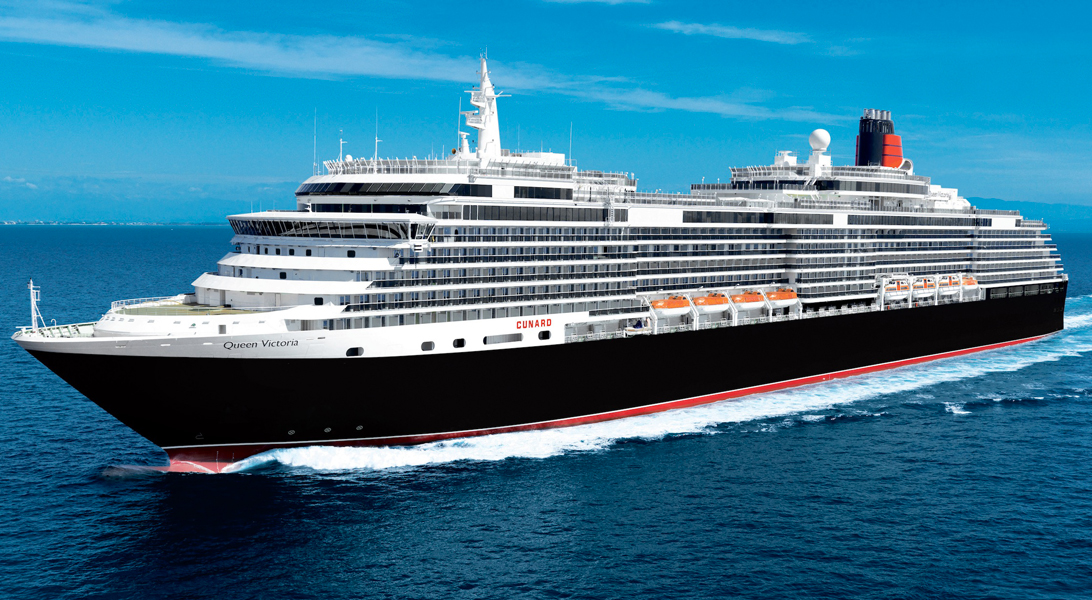












The images shown are for illustration purposes only and may not be an exact representation of what you find on the ship.
The images shown are for illustration purposes only and may not be an exact representation of what you find on the ship.
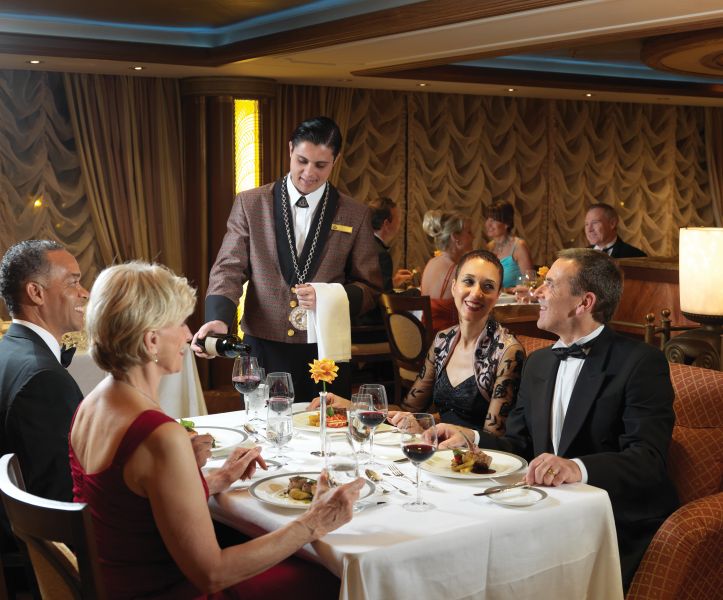
Imaginative cooking and flawless service create a dining experience fit for royalty.
For the exclusive use of guests in our Princess Grill Suites, this exquisite restaurant offers à la carte dining at an elevated level.
With a dining room to rival the world’s most luxurious hotels and a menu that showcases classical flavour pairings, creatively reimagined, the Princess Grill restaurant is among the most prestigious of our on board dining experiences. Discreet but attentive service and a raft of personal touches make every meal special.
You’ll find a comprehensive selection of continental and cooked dishes ready to rouse you each morning, whilst lunchtimes introduce a delicious four course menu alongside lighter options.
Evenings are a particularly grand affair, with the theatre of tableside serving inspiring a greater sense of occasion. Your table for dinner is reserved throughout your voyage, with no need to book; simply take your seat whenever you wish, between 6.30pm and 9.00pm.
Dining at the Princess Grill restaurant is included in your fare if you’re staying in one of our Princess Grill Suites. Relaxed dress is welcomed at breakfast and lunch, and smart attire (jacket optional) after 6.00pm, except on Gala Evenings when we invite you to dress in black tie.
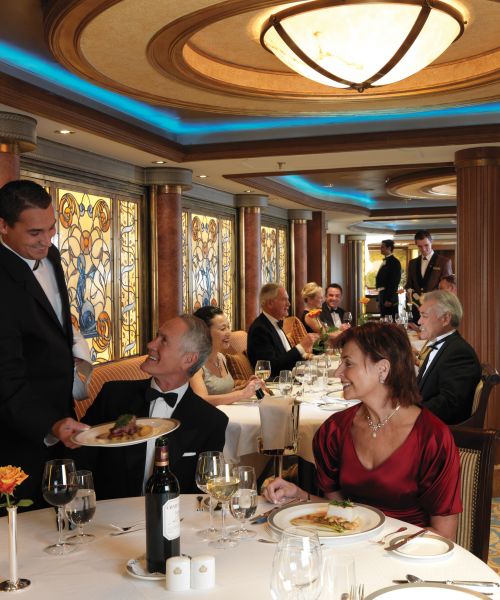
The pinnacle of fine dining at sea, exclusively for guests staying in our Queens Grill Suites.
Drawing inspiration from the world’s finest kitchens, the Queens Grill restaurant offers a true taste of fine dining on board, elevated by a front of house team for whom nothing is too much trouble.
Open for breakfast, lunch and dinner daily, with a Grills Afternoon Tea served separately in the Grills Lounge, a visit to the Queens Grill always feels like a special occasion.
You’ll be dining among your fellow Queens Grill guests, with a table reserved for your exclusive use throughout your voyage. There’s no need to book. Simply arrive whenever you’re ready and your table will be waiting. You may even choose to take your meal in your suite, should you wish.
Each day introduces a coveted line-up of à la carte dishes, complemented by an ‘always-available’ menu of appetisers, entrees, and desserts, executed with exemplary flair and finesse.
Alternatively, opt for one of our chef’s speciality sharing dishes (orderable in advance at breakfast or lunchtimes). From beef wellington to rack of lamb, the choice is truly indulgent. Each dish (along with select offerings on our menu) is finished and presented to you table-side, only heightening the sense of theatre that’s a signature of Queens Grill dining.
Dining at the Queens Grill restaurant is exclusive to Queens Grill guests and included within your Cunard fare. The restaurant operates relaxed dress by day and smart attire (jacket optional) for dinner service after 6.00pm, except on Gala Evenings when we invite you to dress in black tie.
The images shown are for illustration purposes only and may not be an exact representation of what you find on the ship.
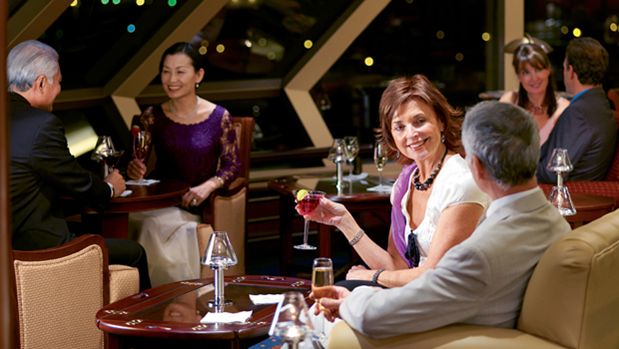
For a Queen Victoria bar with the best sea views, look no further than the Commodore Club. A sophisticated lounge with picture height windows, the Commodore Club offers ocean panoramas like nowhere else on board. You’ll find this popular bar at the bow of Deck 10, above the Bridge. While a full drinks service is offered, the speciality here is a selection of Commodore cocktails, inspired by seven of our fleet’s most decorated Captains. Canapés are served on early evening visits and the atmosphere here is always one of elegance, with soothing background music courtesy of a live pianist.
The images shown are for illustration purposes only and may not be an exact representation of what you find on the ship.

Teenagers 13 to 17 will have a great time with the sports, discos and games we run around the ship.
Teens in your party will have a whale of a time in this dedicated club for 13 to 17 year-olds. They can enjoy deck sports, discos, gaming consoles, quizzes and much more - ensuring an action-packed holiday. They'll also appreciate the special Teen Zone area where they can challenge each other to the latest video games as well as the table tennis tournaments and team games we organise. Note that the exact age groupings will depend on the number of children travelling on any particular voyage.
Access to The Teen Zone is included in your fare.

Enjoy your holiday even more, knowing that your little ones have a safe place to sleep each evening.
There's a great sense of freedom to be had when you can enjoy drinks, dinner or a show knowing that your little ones are sleeping soundly. Available on a first come first served basis, our free of charge Night Nursery equips you with a pager so we can contact you if need be or, if you let us know your plans, we'll come and find you. For that extra peace of mind professional childminders are on hand. Suitable for children aged 6 to 23 months and open from 6pm to 11pm.
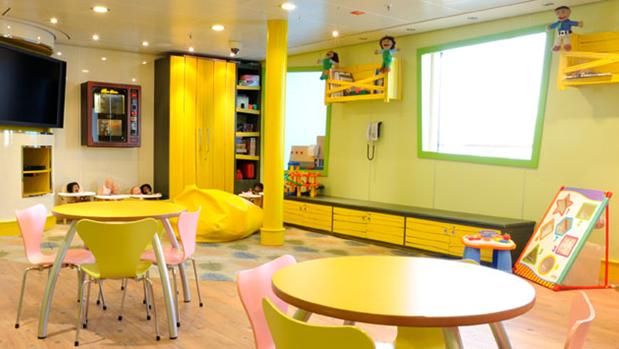
Children aged 2 to 7 will love the activities and themed days in this supervised haven.
The Play Zone is a fully supervised play area which younger members of your family will just love. They're sure to have a fun-filled holiday with the structured activities provided by our fully trained Youth Team - including themed days, arts and crafts, games, books, puzzles, toys and computer games. There's even a sheltered outdoor play area with a range of play equipment such as cars and tricycles. Infants from 6 months to 23 months are welcome to join in the fun, with parental supervision.
Access to The Play Zone is included in your fare.
The images shown are for illustration purposes only and may not be an exact representation of what you find on the ship.
| Return flights including luggage allowance | |||
| Overseas Transfers | |||
| 18 nights aboard the Queen Victoria | |||
| Choose FREE on-board spend, coach transfers or car parking (Cunard Fares only) | |||
| Complimentary daily afternoon tea | |||
| Evening entertainment & Broadway style shows | |||
| Upgrade to the Grills Experience | |||
| Tea, coffee, fruit juice is available 24 hours | |||
| 24-hour room service | |||
| Port Taxes and Fees | |||
 | ABTA and ATOL Protection* | ||
Fly/cruise package |
Date 28th Sep 2026 |
Nts 18 |
Interior £1,799pp |
Oceanview £2,029pp |
Balcony £2,399pp |
Suite  |
Interior £2,049pp |
Oceanview £2,279pp |
Balcony £2,649pp |
Suite  |
Date 28th Sep 2026 |
Nts 18 |
Interior £1,799pp |
Oceanview £2,029pp |
Balcony £2,399pp |
Suite  |
Interior £2,049pp |
Oceanview £2,279pp |
Balcony £2,649pp |
Suite  |


| Interior staterooms from | £1,799pp | ||
| LC | Single Inside |  | |
| GA | Deluxe Inside |  | |
| GB | Deluxe Inside |  | |
| GC | Deluxe Inside |  | |
| IA | Standard Inside |  | |
| ID | Standard Inside |  | |
| IE | Standard Inside |  | |
| IF | Standard Inside | £1,799pp | |
| Oceanview staterooms from | £2,029pp | ||
| KC | Single Oceanview |  | |
| EB | Oceanview |  | |
| EC | Oceanview |  | |
| EF | Oceanview |  | |
| FB | Oceanview |  | |
| FC | Oceanview | £2,029pp | |
| Balcony staterooms from | £2,399pp | ||
| A1 | Club Balcony |  | |
| A2 | Club Balcony | £3,749pp | |
| BA | Balcony |  | |
| BB | Balcony |  | |
| BC | Balcony |  | |
| BD | Balcony |  | |
| BE | Balcony |  | |
| BF | Balcony | £2,399pp | |
| CA | Balcony |  | |
| CB | Balcony |  | |
| Suite staterooms |  | ||
| P1 | Princess Suite |  | |
| P2 | Princess Suite |  | |
| Q1 | Grand Suite |  | |
| Q2 | Master Suite |  | |
| Q3 | Penthouse |  | |
| Q4 | Penthouse |  | |
| Q5 | Queens Suite |  | |
| Q6 | Queens Suite |  | |
| Interior staterooms from | £2,049pp | ||
| LC | Single Inside |  | |
| GA | Deluxe Inside |  | |
| GB | Deluxe Inside |  | |
| GC | Deluxe Inside |  | |
| IA | Standard Inside |  | |
| ID | Standard Inside |  | |
| IE | Standard Inside |  | |
| IF | Standard Inside | £2,049pp | |
| Oceanview staterooms from | £2,279pp | ||
| KC | Single Oceanview |  | |
| EB | Oceanview |  | |
| EC | Oceanview |  | |
| EF | Oceanview |  | |
| FB | Oceanview |  | |
| FC | Oceanview | £2,279pp | |
| Balcony staterooms from | £2,649pp | ||
| A1 | Club Balcony |  | |
| A2 | Club Balcony | £3,999pp | |
| BA | Balcony |  | |
| BB | Balcony |  | |
| BC | Balcony |  | |
| BD | Balcony |  | |
| BE | Balcony |  | |
| BF | Balcony | £2,649pp | |
| CA | Balcony |  | |
| CB | Balcony |  | |
| Suite staterooms |  | ||
| P1 | Princess Suite |  | |
| P2 | Princess Suite |  | |
| Q1 | Grand Suite |  | |
| Q2 | Master Suite |  | |
| Q3 | Penthouse |  | |
| Q4 | Penthouse |  | |
| Q5 | Queens Suite |  | |
| Q6 | Queens Suite |  | |
Early Saver Fare Benefits
Dining time preference ~ Low Deposit ~ T&C’s apply.
| Interior staterooms from | £1,799pp | ||
| LC | Single Inside |  | |
| LC | Single Inside |  | |
| GA | Deluxe Inside |  | |
| GA | Deluxe Inside |  | |
| GB | Deluxe Inside |  | |
| GB | Deluxe Inside |  | |
| GC | Deluxe Inside |  | |
| GC | Deluxe Inside |  | |
| IA | Standard Inside |  | |
| IA | Standard Inside |  | |
| ID | Standard Inside |  | |
| ID | Standard Inside |  | |
| IE | Standard Inside |  | |
| IE | Standard Inside |  | |
| IF | Standard Inside | £1,799pp | |
| IF | Standard Inside | £1,799pp | |
| Oceanview staterooms from | £2,029pp | ||
| KC | Single Oceanview |  | |
| KC | Single Oceanview |  | |
| EB | Oceanview |  | |
| EB | Oceanview |  | |
| EC | Oceanview |  | |
| EC | Oceanview |  | |
| EF | Oceanview |  | |
| EF | Oceanview |  | |
| FB | Oceanview |  | |
| FB | Oceanview |  | |
| FC | Oceanview | £2,029pp | |
| FC | Oceanview | £2,029pp | |
| Balcony staterooms from | £2,399pp | ||
| BA | Balcony |  | |
| BA | Balcony |  | |
| BB | Balcony |  | |
| BB | Balcony |  | |
| BC | Balcony |  | |
| BC | Balcony |  | |
| BD | Balcony |  | |
| BD | Balcony |  | |
| BE | Balcony |  | |
| BE | Balcony |  | |
| BF | Balcony | £2,399pp | |
| BF | Balcony | £2,399pp | |
| CA | Balcony |  | |
| CA | Balcony |  | |
| CB | Balcony |  | |
| CB | Balcony |  | |
| Interior staterooms from | £2,049pp | ||
| LC | Single Inside |  | |
| GA | Deluxe Inside |  | |
| GB | Deluxe Inside |  | |
| GC | Deluxe Inside |  | |
| IA | Standard Inside |  | |
| ID | Standard Inside |  | |
| IE | Standard Inside |  | |
| IF | Standard Inside | £2,049pp | |
| Oceanview staterooms from | £2,279pp | ||
| KC | Single Oceanview |  | |
| EB | Oceanview |  | |
| EC | Oceanview |  | |
| EF | Oceanview |  | |
| FB | Oceanview |  | |
| FC | Oceanview | £2,279pp | |
| Balcony staterooms from | £2,649pp | ||
| BA | Balcony |  | |
| BB | Balcony |  | |
| BC | Balcony |  | |
| BD | Balcony |  | |
| BE | Balcony |  | |
| BF | Balcony | £2,649pp | |
| CA | Balcony |  | |
| CB | Balcony |  | |
Cunard Fare Benefits
Choice of stateroom ~ First priority dining ~ First priority upgrades ~ Choice of on-board spending money*, car parking* or return coach travel* ~ Low Deposit ~ Flexibility to change your booking ~ Complimentary shuttle buses in port (where available). T&C’s apply
*Not available on cruises less than 5 nights
| Interior staterooms from | £2,049pp | ||
| LC | Single Inside |  | |
| LC | Single Inside |  | |
| GA | Deluxe Inside |  | |
| GA | Deluxe Inside |  | |
| GB | Deluxe Inside |  | |
| GB | Deluxe Inside |  | |
| GC | Deluxe Inside |  | |
| GC | Deluxe Inside |  | |
| IA | Standard Inside |  | |
| IA | Standard Inside |  | |
| ID | Standard Inside |  | |
| ID | Standard Inside |  | |
| IE | Standard Inside |  | |
| IE | Standard Inside |  | |
| IF | Standard Inside | £2,049pp | |
| IF | Standard Inside | £2,049pp | |
| Oceanview staterooms from | £2,349pp | ||
| KC | Single Oceanview |  | |
| KC | Single Oceanview |  | |
| EB | Oceanview |  | |
| EB | Oceanview |  | |
| EC | Oceanview |  | |
| EC | Oceanview |  | |
| EF | Oceanview |  | |
| EF | Oceanview |  | |
| FB | Oceanview |  | |
| FB | Oceanview |  | |
| FC | Oceanview | £2,349pp | |
| FC | Oceanview | £2,349pp | |
| Balcony staterooms from | £2,749pp | ||
| A1 | Club Balcony |  | |
| A1 | Club Balcony |  | |
| A2 | Club Balcony | £3,749pp | |
| A2 | Club Balcony | £3,749pp | |
| BA | Balcony |  | |
| BA | Balcony |  | |
| BB | Balcony |  | |
| BB | Balcony |  | |
| BC | Balcony |  | |
| BC | Balcony |  | |
| BD | Balcony |  | |
| BD | Balcony |  | |
| BE | Balcony |  | |
| BE | Balcony |  | |
| BF | Balcony | £2,749pp | |
| BF | Balcony | £2,749pp | |
| CA | Balcony |  | |
| CA | Balcony |  | |
| CB | Balcony |  | |
| CB | Balcony |  | |
| Suite staterooms |  | ||
| P1 | Princess Suite |  | |
| P1 | Princess Suite |  | |
| P2 | Princess Suite |  | |
| P2 | Princess Suite |  | |
| Q1 | Grand Suite |  | |
| Q1 | Grand Suite |  | |
| Q2 | Master Suite |  | |
| Q2 | Master Suite |  | |
| Q3 | Penthouse |  | |
| Q3 | Penthouse |  | |
| Q4 | Penthouse |  | |
| Q4 | Penthouse |  | |
| Q5 | Queens Suite |  | |
| Q5 | Queens Suite |  | |
| Q6 | Queens Suite |  | |
| Q6 | Queens Suite |  | |
| Interior staterooms from | £2,299pp | ||
| LC | Single Inside |  | |
| GA | Deluxe Inside |  | |
| GB | Deluxe Inside |  | |
| GC | Deluxe Inside |  | |
| IA | Standard Inside |  | |
| ID | Standard Inside |  | |
| IE | Standard Inside |  | |
| IF | Standard Inside | £2,299pp | |
| Oceanview staterooms from | £2,599pp | ||
| KC | Single Oceanview |  | |
| EB | Oceanview |  | |
| EC | Oceanview |  | |
| EF | Oceanview |  | |
| FB | Oceanview |  | |
| FC | Oceanview | £2,599pp | |
| Balcony staterooms from | £2,999pp | ||
| A1 | Club Balcony |  | |
| A2 | Club Balcony | £3,999pp | |
| BA | Balcony |  | |
| BB | Balcony |  | |
| BC | Balcony |  | |
| BD | Balcony |  | |
| BE | Balcony |  | |
| BF | Balcony | £2,999pp | |
| CA | Balcony |  | |
| CB | Balcony |  | |
| Suite staterooms |  | ||
| P1 | Princess Suite |  | |
| P2 | Princess Suite |  | |
| Q1 | Grand Suite |  | |
| Q2 | Master Suite |  | |
| Q3 | Penthouse |  | |
| Q4 | Penthouse |  | |
| Q5 | Queens Suite |  | |
| Q6 | Queens Suite |  | |
Fusion Cruises when selling travel arrangements is a trading name of The Midcounties Co-operative Ltd. Fusion Cruises is an Accredited Body Member of Midcounties Co-operative Travel Consortium. (ABTA:P6652, ATOL:6053).
Book with Confidence. We are a Member of ABTA which means you have the benefit of ABTA’s assistance and Code of Conduct.
Some of the flights and flight-inclusive holidays on this website are financially protected by the ATOL scheme but ATOL protection does not apply to all holiday and travel services offered on this website. This website will provide you with information on the protection that applies in the case of each holiday and travel service offered before you make your booking. If you do not receive an ATOL Certificate then the booking will not be ATOL protected. If you do receive an ATOL Certificate but all parts of your trip are not listed on it, those parts will not be ATOL protected. Please see our booking conditions for information, or for more information about financial protection and the ATOL Certificate go to: www.caa.co.uk
